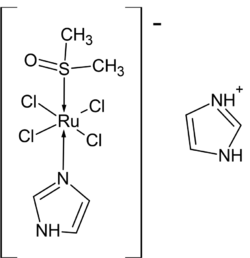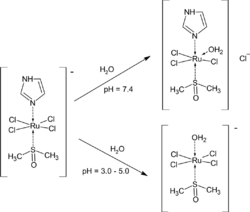Biology:NAMI-A
 | |
| Clinical data | |
|---|---|
| Routes of administration | Intravenous |
| ATC code |
|
| Identifiers | |
| |
| CAS Number | |
| UNII | |
| Chemical and physical data | |
| Formula | C8H15Cl4N4ORuS |
| Molar mass | 458.17 g·mol−1 |
NAMI-A is the imidazolium]] salt of the coordination complex [RuCl
4(dmso)(C
3N
2H
4)]−
where dmso is dimethylsulfoxide and C
3N
2H
4 is imidazole Together with KP1019 and BOLD-100, NAMI-A has been investigated as an anticancer agent.[1][2][3]
Reactions
NAMI-A is considered a pro-drug formulation that becomes active upon hydrolysis. At pH 7.4, a chloride is replaced by water giving a charge-neutral aquo complex. At lower pH, imidazole is cleaved and replaced with water.[4]
Unlike cisplatin, a platinum based drug, NAMI-A affects metastasis.[5] Whereas platinum compounds can be highly cytotoxic, NAMI-A is much less so.[6]
Preclinical trials
Several preclinical trials were conducted in various model systems.
In 2002, a study published by Vacca et al. showed that endothelial cells incubated with NAMI-A, were not able to proliferate but that NAMI-A did not kill the cells that were already grown.[7]
One trial was done to test the efficacy of NAMI-A in female[8] grafted with MCa mammary carcinoma cells. It was determined that, NAMI-A showed very little toxicity yet managed to decrease the rate of metastasis. Perhaps most impressively is that, though NAMI-A is very sensitive to the environment, it is able to be effective over a range of conditions.[4]
Clinical trials
Clinical trials were conducted at the Netherlands Cancer Institute (NKI).
Phase I – monotherapy
Phase I trials were conducted on NAMI-A in patients with varying solid tumors 3 hrs a day, 5 days a week, for 3 weeks at varying doses. Drug was given intravenously with and without a port-a-cath. Several side effects were observed including:[9]
- Mild hematologic toxicity - blood related toxicity
- Nausea
- Vomiting
- Diarrhea
- Stomatitis – inflammation of mouth and lips
- Fatigue
- Creatinine increase – common toxicity (CTC) grade 1 and 2 - High levels indicate kidney dysfunction
- Fever
- Sensitivity reactions to drug
- Phlebitis at injection site
- Blisters on hands and feet
Of the 24 patients in the study, 20 were evaluated for final results. At the end of the study, 19 of the 20 showed disease progression while 1 patient showed no progression.[9]
Due to these results, Phase II trials, using NAMI-A as a solo drug, were not pursued.[citation needed]
Phase I and II – combination therapy with gemcitabine
Due to negative results of the stand-alone Phase I trial, and knowledge that NAMI-A slows down progression of metastasis, and not growth of the initial tumor, Phase I & II trials were done using gemcitabine, a nucleoside analog that has shown to be successful in treating lung cancer.[citation needed]
Phase I trial
Phase I trials were done to determine the optimal and maximum tolerated dose (MTD)of NAMI-A as well as determining the pharmacokinetics of NAMI-A and gemcitabine administered jointly. This was accomplished by a dose escalation study. The minimal dosage was 300 mg/m2 on a 28-day schedule and the max dosage was 600 mg/m2 administered on a 21-day schedule. 32 patients were enrolled in the study all of which had a form of non-small cell lung cancer (NSCLC), a median age of 57, most diagnosed as level III & IV of disease progression.[9]
Phase II trial
Phase II trials were done to evaluate how NAMI-A in combination with gemcitabine impact cancer progression. 19 patients were added in addition to those from the phase I trial. Of the 27 patients evaluated for final results -15 showed anti-tumor activity, 10 showed stable disease progression for 6–10 weeks, and 1 patient exhibited a partial remission (PR) on the 300 mg/m2 for 21 days.[citation needed]
The patient who was observed to have a partial remission, occurred during the dose escalation phase I trial. In order to expand the trial, there needed to be at least one patient in the phase II trial that showed PR as the best response. Unfortunately, this did not occur. In addition, it was found that the results of NAMI-A in combination with gemcitabine, did not show improved results from studies done with gemcitabine alone.[9]
Due to these results, clinical trials were terminated.[citation needed]
Nomenclature
Contrary to what can be found in some papers, the nickname NAMI is not the acronym of “New Anticancer Metastasis Inhibitor”, but has a much more prosaic origin. It was created by a student as a short-form name of the chemical formula of the complex: “NA” comes from the symbol for sodium and “MI” from the word imidazole. The corresponding imidazolium salt was simply called NAMI-A to signify that it was an upgraded version of the prototype NAMI".[10]
References
- ↑ "Ruthenium complexes as anticancer agents". Current Medicinal Chemistry 13 (9): 1085–1107. 2006. doi:10.2174/092986706776360941. PMID 16611086.
- ↑ "Pharmacokinetics of a novel anticancer ruthenium complex (KP1019, FFC14A) in a phase I dose-escalation study". Anti-Cancer Drugs 20 (2): 97–103. February 2009. doi:10.1097/CAD.0b013e328322fbc5. PMID 19209025.
- ↑ "Chapter 5. The Deceptively Similar Ruthenium(III) Drug Candidates KP1019 and NAMI-A have Different Actions. What Did We Learn in the Past 30 Years?". Metallo-Drugs:Development and Action of Anticancer Agents. Metal Ions in Life Sciences. 18. Berlin: de Gruyter GmbH. 2018. pp. 141–170. doi:10.1515/9783110470734-011. ISBN 9783110470734.
- ↑ 4.0 4.1 "Influence of chemical stability on the activity of the antimetastasis ruthenium compound NAMI-A". European Journal of Cancer 38 (3): 427–435. February 2002. doi:10.1016/S0959-8049(01)00389-6. PMID 11818210.
- ↑ "Dual Action of NAMI-A in inhibition of solid tumor metastasis: selective targeting of metastatic cells and binding to collagen". Clinical Cancer Research 9 (5): 1898–1905. May 2003. PMID 12738748. http://clincancerres.aacrjournals.org/content/9/5/1898.full.pdf.
- ↑ "In vitro cell cycle arrest, in vivo action on solid metastasizing tumors, and host toxicity of the antimetastatic drug NAMI-A and cisplatin". The Journal of Pharmacology and Experimental Therapeutics 289 (1): 559–564. April 1999. PMID 10087050. http://jpet.aspetjournals.org/content/289/1/559.full.pdf.
- ↑ "Inhibition of endothelial cell functions and of angiogenesis by the metastasis inhibitor NAMI-A". British Journal of Cancer 86 (6): 993–998. March 2002. doi:10.1038/sj.bjc.6600176. PMID 11953835.
- ↑ "Mice, Inbred CBA". WikiGenes. https://www.wikigenes.org/e/mesh/e/1318.html.
- ↑ 9.0 9.1 9.2 9.3 "Phase I/II study with ruthenium compound NAMI-A and gemcitabine in patients with non-small cell lung cancer after first line therapy". Investigational New Drugs 33 (1): 201–214. February 2015. doi:10.1007/s10637-014-0179-1. PMID 25344453.
- ↑ "Thirty Years of the Drug Candidate NAMI-A and the Myths in the Field of Ruthenium Anticancer Compounds: A Personal Perspective". European Journal of Inorganic Chemistry 2017 (12): 1549–1560. September 28, 2016. doi:10.1002/ejic.201600986.
External links
 |


